Latest News
Kitchen Chat and more…
Kitchen Chat and more…
What does port wines and whisky have in common? I am glad you ask. If you notice, port cask finished whiskies gained some reputation in recent years, as distillers experiment with port casks to insert variety into the whisky scene. What do we know about port wines? Most whisky drinkers who do not drink wine possibly know very little, so I think we must set it right because port cask finished whiskies are getting popular.
Port is a fortified wine that is produced exclusively in the Douro Valley in Portugal. The Instituto dos Vinhos do Douro e do Porto regulated port production massively through stringent rules. Producers of port wine must make, label and market their products in a specific way as stated by the Instituto dos Vinhos do Douro e do Porto. In this sense, port wine production is similar to Scotch whisky as the Scotch Whisky Association (SWA) also controls and regulate the production.
Due to the rules in place for port wine, its authenticity is easy to spot. One simple rule of thumb to identify an authentic bottle of port wine is to look for a white seal that reads “Vinho do Porto Garantia” (see below).
Port wine is what red wine wants to be when it grows up. Producers add aguardiente (which most referred to as “brandy”) into red wine to create port wine. The brandy increases the alcohol content to 20% abv on average and stops the fermentation process to preserves natural sugars from the grapes. The common term for this process is fortification. Interestingly, fortification also warmed the body and made port wine a good substitute for whisky in long, winter months.
Grapes are the essential ingredients of port wines. These grapes are Portuguese indigenous grapes, which make port wine so unique. Some variety of Portuguese port grapes include Touriga Nacional, Touriga Franca, Tinta Roriz (aka Tempranillo), Tinta Cāo and Tinta Barroca. I understood from Wine Folly that there are at least 52 varieties in port wine! Each type of grapes gives different flavours to create a complex and flavourful end-product.
Typically, there are two kinds of port wines – the barrel-matured port and bottle-matured port. Barrel-matured port made up 98% of all port wines while the remaining 2% comes from the bottle-matured process. All port spend some time in barrels, but bottle-matured port wines spend significantly lesser time in oak cask than barrel-matured port wines.
Bottle-matured port wines are rare with only exceptional vintages that age for decades in the bottles. These port wines are expensive and only sought-after by wine connoisseurs.
From the two kinds of port wines, producers split them into four main styles.
Here is an infographic to help you understand the flavours of port wines.
In general, a ruby port is deep-red in colour and includes the Vintage, Late-bottled Vintage (LBV), Crusted and Ruby Port. A Tawny port is barrel-aged with sweet nuts and caramel flavours. A white port is unique as it used white grapes such as Viosinho, Gouveio, Rabigato and Malvasia. Finally, a rose port is a new style in which the producer make port wine like rose wine with strawberry, violets and caramels flavours.
The discussion on port wines make me curious about the history, and I discovered some interesting nuggets from Google. Port wines existed since 1678 in Portugal. Thanks to the fall-out between England and France, England restricted the import of French wines during the 1600s. Portugal and England, however, were buddies. The obvious supply of wine to England was Portugal, but the tricky part was keeping them fresh during transit. The solution was to add brandy to the wine. The export of the fortified wine shipped from the town of Oporto, and hence, the fortified wine was named “port”.
There are many port-finished whiskies to choose from in today’s whisky scene. Some of the well-known Scotch is Balvenie 21 Portwood, Glenmorangie Quinta Ruban and Tomatin 14 Port Wood Finish. Most of these port-finished whiskies are flavourful and sweet, gaining fame amongst those with a sweet tooth. They are also popular with sherry lovers since they share some similar qualities.
While port casks are not yet as prominent in the whisky industry as sherry casks are, there may come a day when port casks become a necessary component in maturing whisky! Therefore, drink some port wines and do your part to create more casks for the whisky industry!
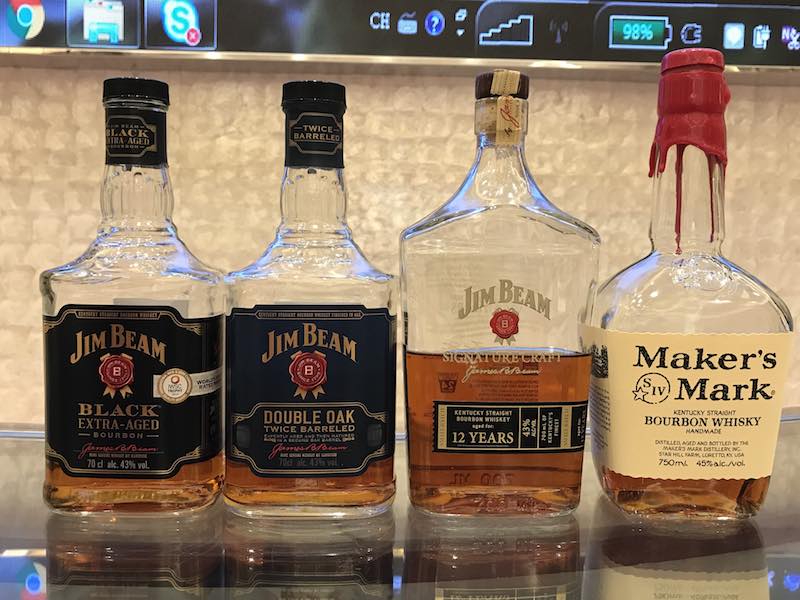
From left: Jim Beam Black, Jim Beam Double Oak, Jim Beam Signature Craft and Maker’s Mark
A whisky shop owner invited Geek Choc and me to a tasting session that he hosted with his wife during our short stay in Kaohsiung. It was an eye-opening session for us, and one which we will not be forgetting anytime soon. It happened totally at random as we went to the shop because a friend told me that the shop has a lot of Bruichladdich bottles, including one which I was looking for.
We arrived with a high expectation, and the shop did not disappoint us at all. It started out a little awkward, but as we got to know the boss and lady boss, we began to chit chat about whisky and all things Taiwan vs. Singapore. The boss then invited us to a tasting session of Jim Beam, which took place one day before we left Kaohsiung. We accepted the invitation readily as we were very curious about how Taiwanese ran their whisky tasting sessions. We were glad that we did because it was indeed different and entirely out of our expectations.
The boss told us that the tasting session was for Jim Beam. While we lamented that it was not a Scotch whisky tasting, we thought that Jim Beam should still be interesting to us, as we never drank it before. The line up was four different drams with significant differences.
They are Jim Beam Black, Jim Beam Double Oak, Jim Beam Signature Craft and finally, Maker’s Mark. Out of the four, we tried Maker’s Mark before and enjoyed it with ice.
The organiser held the event at a new hotel in Kaohsiung, named Lin Hotel. It is a luxurious and lavish hotel completed with much opulence. We were stunned when our taxi drove us up to the lobby, and we breathed a sigh of relief that we dressed up for the event. The hotel had arranged the tasting session in a private room within their seafood restaurant, and it was a small, cosy place. It sat about thirty people comfortably and had a small area for displaying the four whiskeys.
The setting looked like a small intimate Chinese wedding dinner, with three tables for ten pax each placed at strategic locations. Everyone seated could see the big screen in the middle. Once 90% of the participants turned up, the event started promptly. The organiser did not wait for latecomers – which was interesting for us.

Brand Ambassador of Jim Beam
The speaker for the event is none other than the brand ambassador of Beam Suntory in Taiwan. I need to apologise that I completely missed his name as I am bad with names. He is a knowledgeable man and explained much about American whiskey. The only thing that I feel that he could do better is to slow down. The speed of the presentation and tasting session was too fast, which was not ideal considering that most of the participants were avid drinkers who wanted to taste the whiskeys properly.
Nonetheless, he shared the history of Jim Beam and how it came about with the audience and what proved to be of interest to me was the history of Jim Beam. It was the oldest Kenturkey bourbon ever – sold for the first time by founder Jacob Beam in 1795. It was a short but insightful session. I loved it when brand ambassador waxed lyrical about the history of the brand and the distillery because it helped me to understand the whiskey better.
The brand ambassador also shared the history of how charred barrels came from as Jim Beam charred their barrels to level 4 to get the most of the butterscotch, vanilla, coconut and caramel flavours. History has it that charring had a very different purpose in the past. One theory said that it was to kill germs – burning the wood was the best way. Another argument, which was popular, said that a greedy merchant tried to cheat the system by using secondhand barrels. To remove the smell and taste of the previous liquid, he burnt the insides of the barrel badly. By accident, the charred barrels produced excellent results, and hence the idea took off.
Besides barrels, the brand ambassador also explained the rules of making bourbon. It must be at least 51% corn, and the remaining 49% can be made up of rye and barley. While he did not tell us the exact make-up of Jim Beam, he did mention that Jim Beam is a proper Bourbon. Due to the temperature at Kenturkey, Jim Beam’s angel share is about 4%, and the first-fill bourbon barrels influence the liquid up to about 60%.
After the presentation (which was too fast for me), we tasted the whiskeys. These were the four glasses that we had.
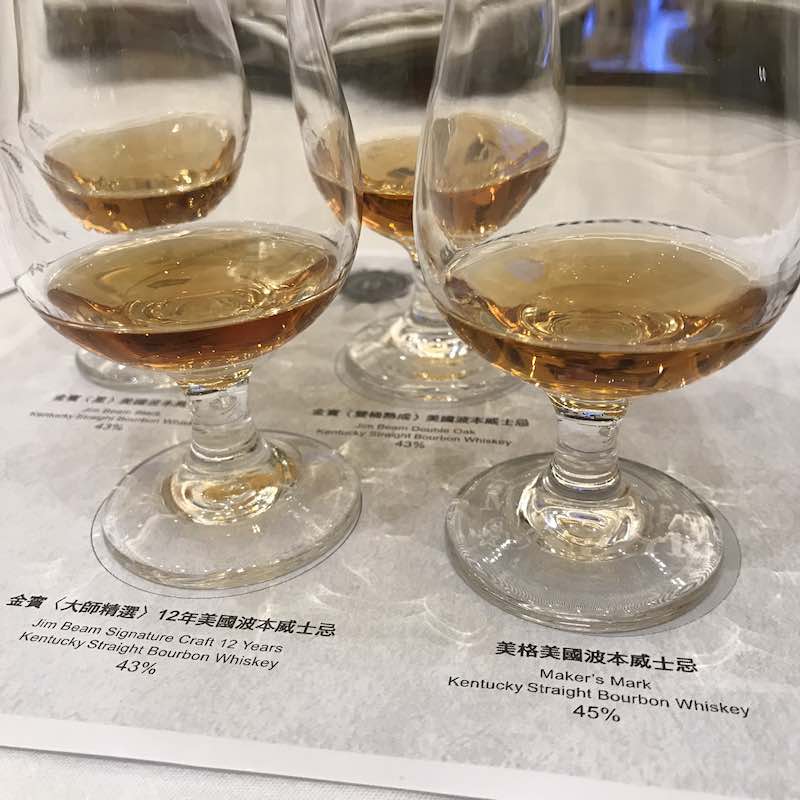
Besides the four glasses, two pitchers of Jim Beam Black sat on the table, for anyone who wanted a top up. We found the session to be completely generous as it was also free.
We started out with Jim Beam Black. We understood that the black label is supposed to be better than the white label.
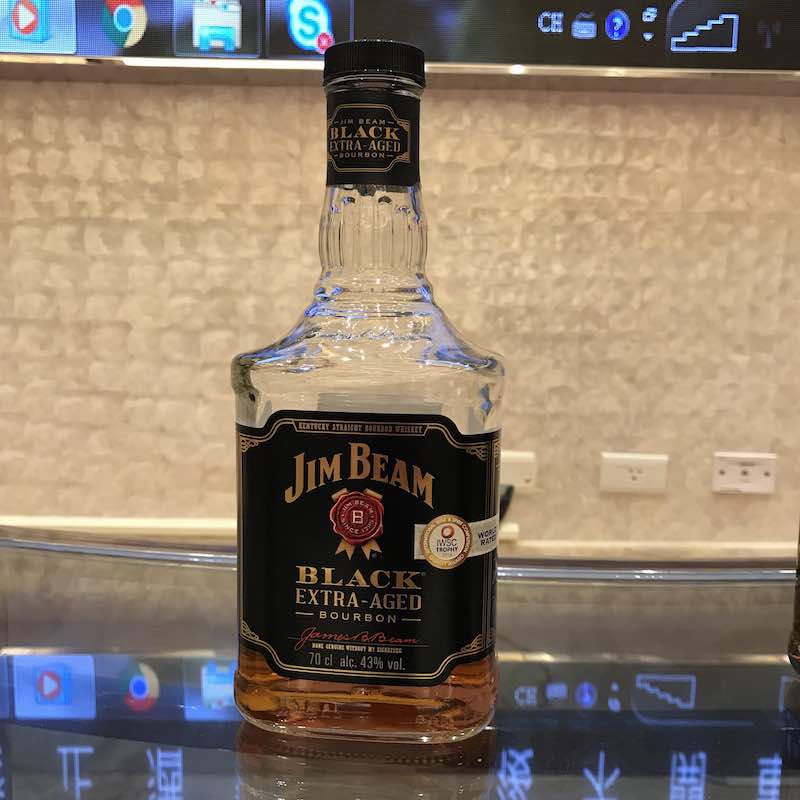
Jim Beam Black
Jim Beam Black is 43% abv with a bright gold colour. It has a strong coconut and caramel nose with butterscotch and spice in the background. A creamy mouthfeel with coconut, caramel, vanilla and gentle spice follows in the palate. The finish is short to medium with sweet caramel all the way.
It is a simple whiskey and one which can be enjoyed neat, on the rocks or in a cocktail. Personally, this is one of my favourites among the three Jim Beam bottles.
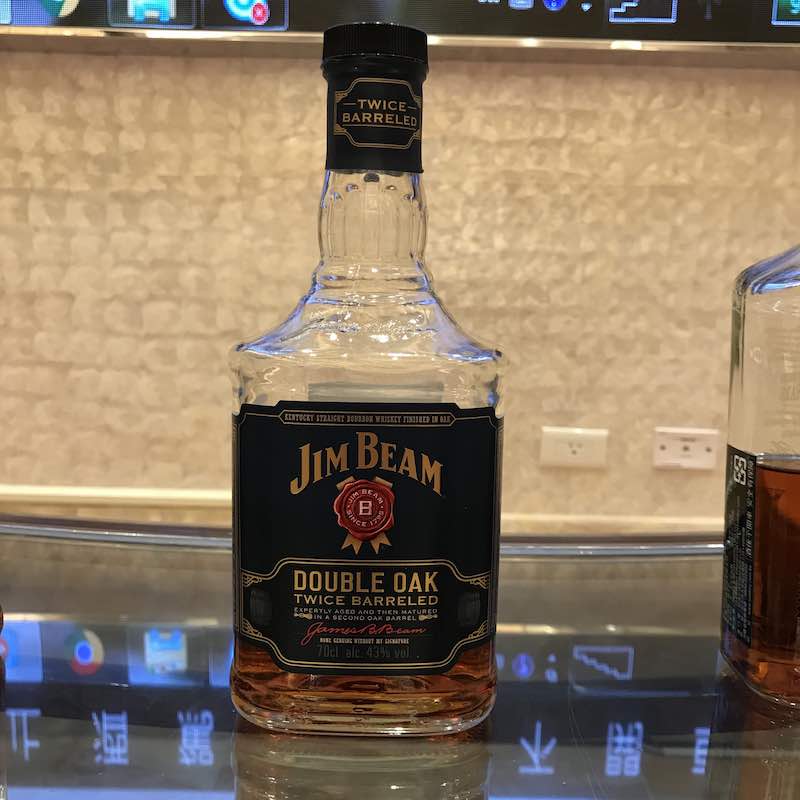
Jim Beam Double Oak
The next whiskey up for tasting is the Jim Beam Double Oak. It is an excellent whiskey to showcase the influence of wood. Again at 43% abv, it gives a beautiful bright gold colour too. The nose promises a fuller flavour with coconut and caramel complementing the spice. The palate has a sharper bite to it, and the oak influence creates sandalwood notes in addition to the expected coconut, caramel, and vanilla. The mouthfeel is less creamy but oilier. It is also oakier. The finish is longer than Jim Beam Black with the sandalwood notes lingering all the way.
The Jim Beam Double Oak is a love-it-or-hate-it kind of whiskey. The stronger flavours may appeal to some but not others. Geek Choc likes this expression best out of the three Jim Beam, but I find it harder to accept.
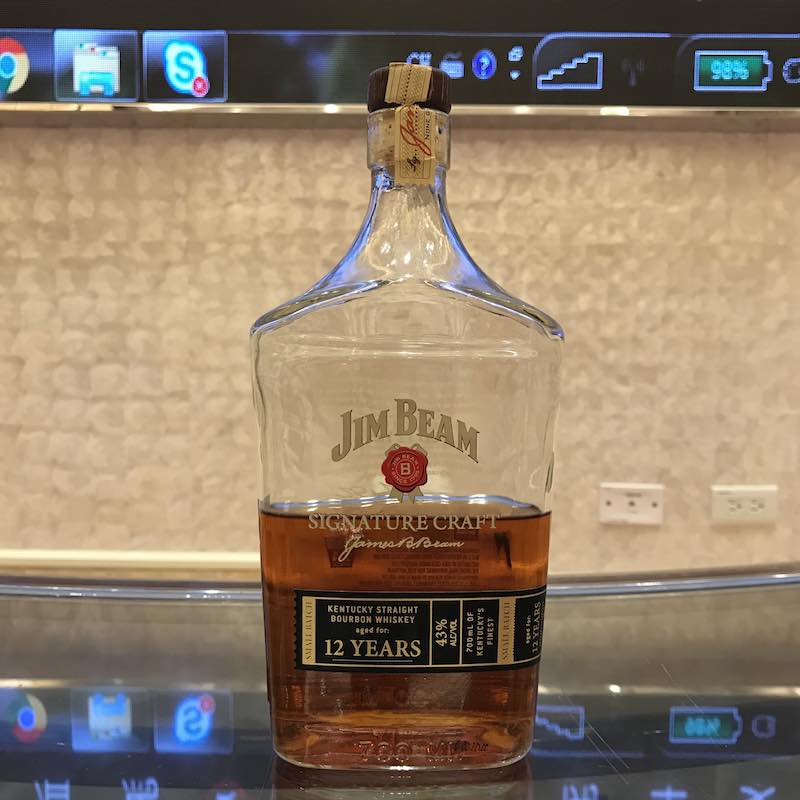
Jim Beam Signature Craft
The Jim Beam Signature Craft is unique because it aged for 12 years before bottling. For those who know about bourbon, you know that bourbon does not age for more than five to six years typically. For an expression to reach 12 years of age is not an easy feat. The Signature Craft is also 43% abv and spot a gold colour that is slightly brighter than the above two expressions.
The aromas from the nose are more mellow than the other two expressions. Coconut and caramel couple with vanilla waft up the nose with no sharpness. There is also no spice detected. The palate is oily and creamy, with beautiful notes of coconut, caramel, vanilla ice cream and hints of spice. It feels mellow, smooth and more aged. The finish is long with sweet coconut and gentle spice. Slightly oaky in the end too, but nothing unpleasant.
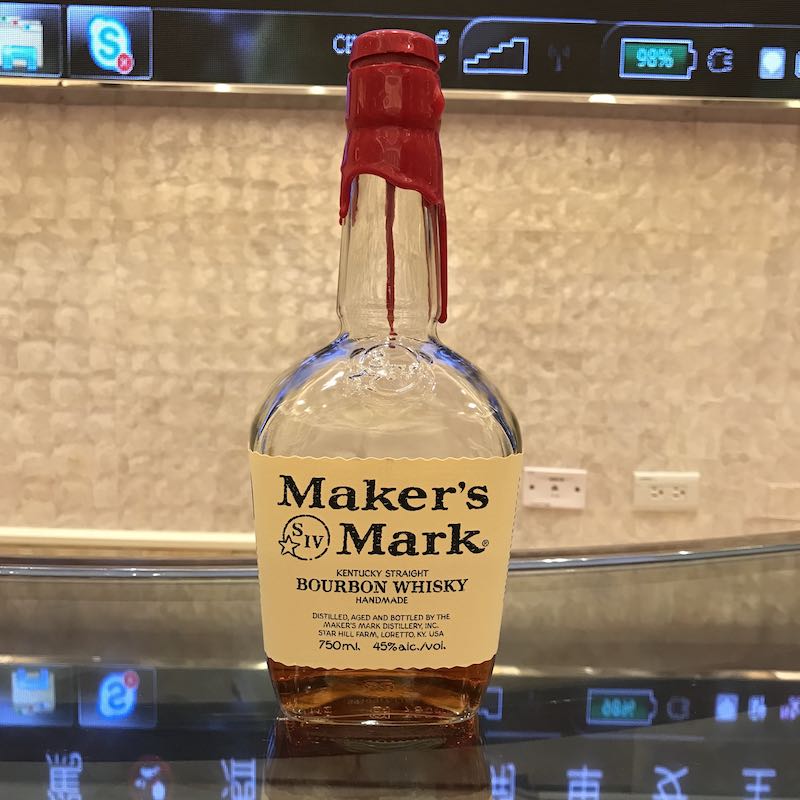
Maker’s Mark
Finally, we had Maker’s Mark. While it is not from the Jim Beam family, it is produced together in the distillery. I like Maker’s Mark as I find the notes of honey, vanilla, and coconut to be perfect as a whiskey on the rocks.
The nose is full of honey, coconut and caramel in the forefront and vanilla hiding in the background. The palate speaks with spiced coconut, caramel, and honey at first before vanilla cream appears to give another layer of complexity. The finish is short with spiced coconut lingering all the way.
I must admit that the dinner which followed the whiskey tasting was the best surprise of the night. We expected a series of finger food and snacks, but a 10-course Chinese meal came instead. When course after course arrived at the table, we were stunned beyond words. The food served was lip-smacking good – drunken prawns, smoked duck, steamed fish, and the list went on.
The whole event ended after dinner. The organisers offered up bottles for sales at a reasonable price and many of the participants bought by the cartons. For us, we only bought two bottles as we still have a long trip ahead of us in Taipei.
We had a great time and indeed, opened our eyes to how a tasting event can be done. It is as different as it can be in Singapore and I think the same scale will be hard to replicate here due to cost. While this tasting is not representing every tasting session in Taiwan, we believe that it is a great way to get people together to enjoy good food and whisky.
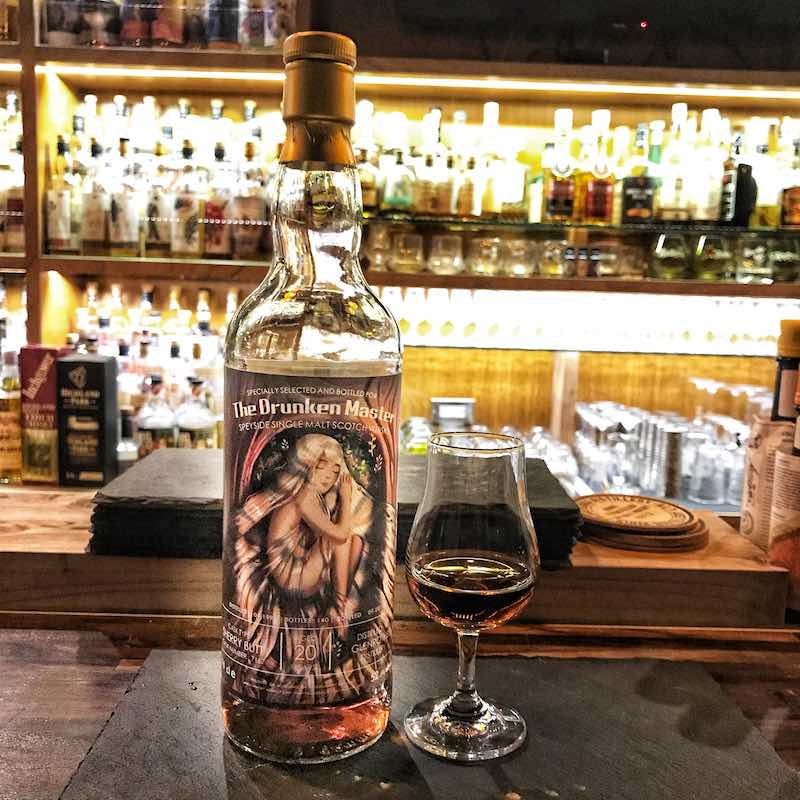
TDM Glenrothes 1997
Today’s review is a Glenrothes that I happened to enjoy so much that I wish that I can bring back more bottles. The Drunken Master Pte Ltd is an independent bottler who also runs The Drunken Master Whisky Bar in Kaohsiung. The owner, Mr Li Chunfeng, is also the organiser for the Whiskyfair Takao.
This Glenrothes is part of a shared cask with Michael Hsieh, the owner of ARen Trading Pte Ltd. Michael has his label for this cask, while Chunfeng has his own. While the liquid is technically the same, the different labels make each bottling unique and worthy of collection.
The liquid is also one which impresses me. I am not a fan of sherry bombs, because sulphuric notes are often involved. I do not like sulphur in my whisky, and hence, I usually avoid sherry bombs. However, this sherry bomb is worthy to mention, because I love it. Why? Let’s find out.
Colour: Dark Amber
ABV: 52.3%
Nose: Dark chocolates, raisins, sultanas and dark red fruits come together to create an aroma that I am unlikely to forget in a long time. Spice lingers underneath but does not overwhelm any of the other notes in the nose. It is a sherry bomb alright! (17/20)
Palate: Pepper spice, sweet raisins, sultanas and dark chocolate all engulf the palate without knocking one another out to create a medley of flavours all over the tongue. As the liquid travels to the back of the palate, the tip of the tongue turns slightly dry and give rise to more sweetness at the back of the mouth. (18/20)
Finish: It has a super long finish. The spice follows all the way to the throat, with dark chocolate and a crisp dryness to the finish. Hints of raisins linger all the way with some oakiness. (18/20)
Body: This is a very balanced dram with all the right notes of a sherry cask liquid. I like that there is no liquorice or sulphuric notes in this whisky and yet, the other typical sherry notes of raisins, sultanas and dark chocolate are all complementing one another in an almost perfect harmony. (37/40)
Total Score: 90/100
Geek Flora: “It is quite a perfect whisky for me as a sherry bomb. It has all the right flavours without having the unpleasant notes of sulphur in it. Love it and hope to get more bottles from TDM!”
Geek Choc: “Well, I love a sherry bomb, and this is one which will stay with me for quite some time to come. I love the way the dark chocolate displayed itself so significantly in the palate. It is not every day that we get to taste a delicious sherried whisky.”
11311 Harry Hines Blvd
Dallas, TX, United States
(555) 389 976
dallas@enfold-restaurant.com
